
On a Friday night in late August, I headed north from Seattle with Iris, Phillip, and Jordan - three friends I’d made in the Everett Basic Climbing course. We were on our way to Ruth Mountain and Icy Peak to try what’s known as the Ruth and Icy Traverse - a linkup of two glaciated summits on the border of North Cascades National Park.
The four of us had done many trips like this over the summer. As Basic students, we’d climbed some big mountains, including Baker, Dragontail Peak, and Sahale, and made a private trip up Rainier via the DC route. This trip was different, though. There were no climb leaders to lean on and no professional guides marking the safe path. What’s more, the glaciers on Ruth and Icy were in late-season condition, with crevasses exposed or lurking under thin snow. But we wanted one more chance to use the skills we’d accumulated over the year before the climbing season ended - one more challenge to measure how far we’d come. We were unsure if attempting the traverse was wise, but after some deliberation, we committed to what I’ve come to find is the true spirit of adventure: going up in the face of uncertainty and having a look at the mountains for ourselves.
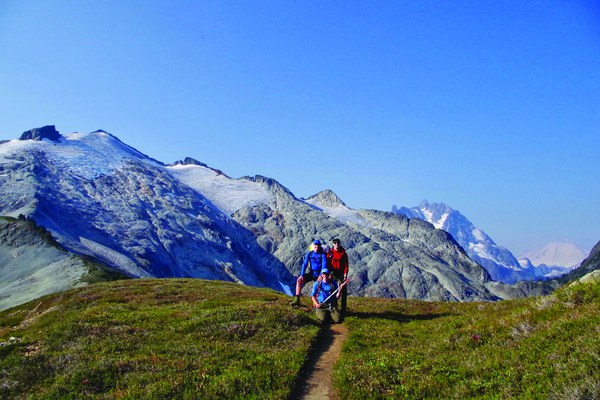 Phillip, Matt, and Jordan on the trail from Ruth Mountain with Mt. Shuksan and Mt. Baker visible. Photo by Iris Lieuw.
Phillip, Matt, and Jordan on the trail from Ruth Mountain with Mt. Shuksan and Mt. Baker visible. Photo by Iris Lieuw.
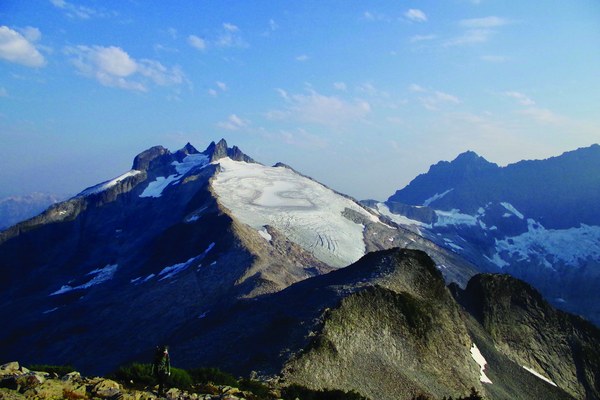 Icy Peak's northwest face from Ruth Mountain. Photo by Phillip North.
Icy Peak's northwest face from Ruth Mountain. Photo by Phillip North.
Having a look
The Basic Climbing course teaches you a lot of things. The marquee technical skills are well advertised: you’ll learn to travel safely on a glacier and to belay a leader on a rock climb, follow them up, and rappel back down. You’ll also accumulate a number of useful skills that aren’t mentioned in the curriculum. These include strategies for hanging technical gear off your overstuffed backpack like tree ornaments, managing your caffeine addiction in the face of an alpine start, and knowing which assortment of powders and bars will keep your body fueled well past the 5,280th vertical foot it has ascended in a day.
And then there are the soft skills: teamwork, risk mitigation, and decision making. On Saturday morning around 5am -which, at some point over the summer, had become “sleeping in” - we began the day that would put each of these skills to use. We lugged heavy packs up the trail toward Hannegan Pass, soon catching our first views of Ruth. As expected, we saw a glacier striated with exposed crevasses: an intimidating sight to be sure. But we had a lot more walking before we would have to face that obstacle, so we kept moving forward.
Plenty of treats satisfied us along the way: views of the distant Chilliwacks silhouetted in wildfire smoke, Mt. Shuksan’s terrible north face on the other side of the valley, ripe trailside blueberries ready for picking. By mid-morning, we had gone as far as we could up a ridge that cleaved the north side of Ruth’s glacier. Standing on a rocky prow surrounded by ice, we used beta from past trip reports to make out the general line people had taken to the summit, but that’s where help from the outside ended.
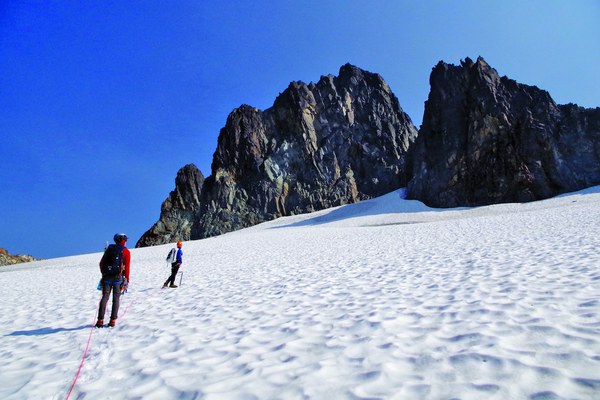 Jordan and Phillip ascending the glacier on Icy Peak's northwest face. Photo by Iris Lieuw.
Jordan and Phillip ascending the glacier on Icy Peak's northwest face. Photo by Iris Lieuw.
We rested and scanned the glacier. To our right lay stripes of long, parallel crevasses completely devoid of snow. To our left was a plate of exposed glacial ice that rolled over the mountainside into oblivion. The ice reflected the sun like a sheet of metal. Neither of those paths were passible. And so, half a dozen miles and a few hours into this trip, we faced the possibility that we might turn back.
A finger of unmelted snow filled a crease in the ice ahead of us. It looked to be the perfect ramp to get over the glacier’s initial hump. Stepping off the sturdy rock where we’d safely been standing would be our first brush with danger. Scanning our limited options, I felt quite aware of how remote we were.
In a moment hinting at the transcendent strength of a good team, I said something along the lines of, “Hey, I’m nervous about this.” To my relief, my teammates - who had looked so keen - said with smiling (and somehow still keen) faces, “Same!”
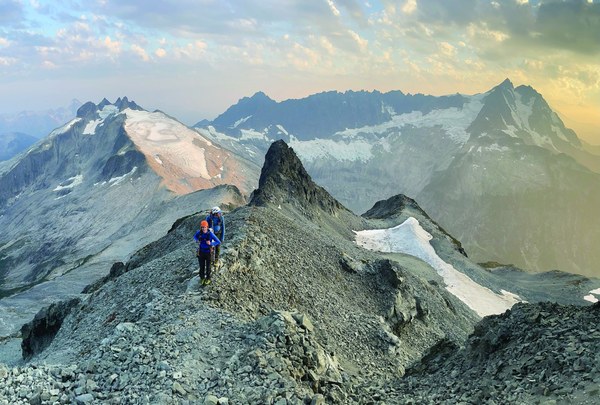 Phillip and Matt returning to the summit of Ruth Mountain. Photo by Jordan Lewis.
Phillip and Matt returning to the summit of Ruth Mountain. Photo by Jordan Lewis.
We sat and sipped water from a stream of glacial runoff while discussing whether to continue. Through the enumeration of facts and attempts at objective risk assessment, I kept returning to a question that my Mountaineers instructors often prompted: How am I safe?
The answer in this case was my dependable team. I had seen Iris, Phillip, and Jordan diligently practice self-arrest and crevasse rescue for months during our course and was confident we would be able to halt a fall or fish each other out of most holes in the ice that might nab us. I also knew from our many conversations off the mountain that we shared a similar appetite for risk. I trusted them, and trusted our wherewithal to turn around when pressing forward no longer made sense.
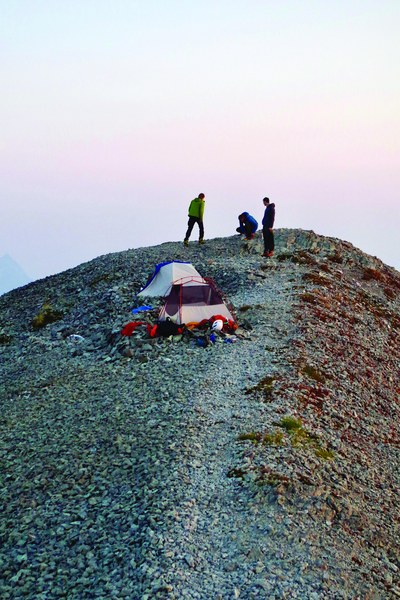 Phillip, Matt, and Jordan resting at camp on top of Ruth Mountain. Photo by Iris Lieuw.
Phillip, Matt, and Jordan resting at camp on top of Ruth Mountain. Photo by Iris Lieuw.
Becoming acquainted with glaciers
We elected Phillip as leader and roped up. Phillip took a brave first step onto the snow finger, prodded it with his axe, kicked a step, and judged it firm enough. He continued up the five-foot-wide ramp between the sheets of shining ice, kicking steps and testing as he climbed. Soon, the rope became taught and Jordan started up the snow after Phillip. Then Iris was pulled on, and finally it was my turn. We were a caterpillar threading upward through the lattice of crevasses.
We made our way to the top of Ruth, and later to the top of Icy Peak. As we navigated the glaciers, I couldn’t help but reflect on their tremendous beauty. They reminded me of my smallness, both in space and time.
Though to our eyes glaciers appear frozen in place, they are in fact quite alive. Like cookie dough packed into a mountainside, their incomprehensible weight pulls them downward as they stretch and ooze along paths of least resistance. With a nudge from the underlying terrain, they climb, turn, and dive, fracture, crash, and stack up. Where the direction or steepness of their path changes, they wrinkle, crack, and break into pieces, creating crevasses so hazardous to climbers yet so orderly in their parallel rows. What weight the glaciers must bear to turn this solid ice into the viscous mass that carves mountains.
All this was new to me. I’d seen and read about glaciers over the years, but there is no substitute for the up close, tactile experience made possible through the Basic course. I had a new fondness for this terrain, a happy side effect of learning how to safely travel through it.
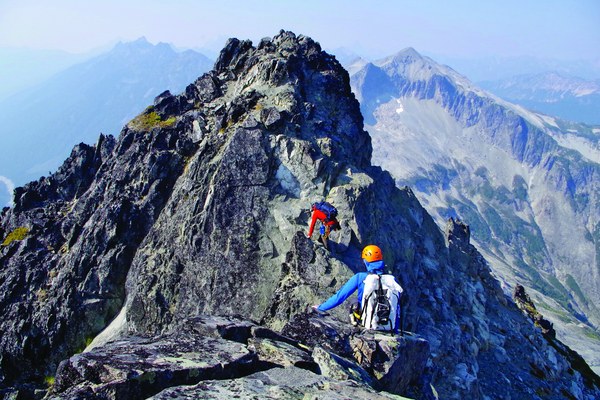 Phillip and Jordan descending the summit ridge on Icy Peak with Ruth Mountain in the background. Photo by Iris Lieuw.
Phillip and Jordan descending the summit ridge on Icy Peak with Ruth Mountain in the background. Photo by Iris Lieuw.
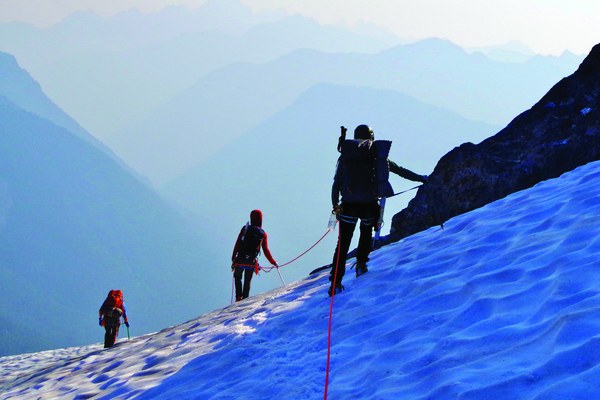 Matt, Jordan, and Iris descending Ruth Mountain. Photo by Phillip North.
Matt, Jordan, and Iris descending Ruth Mountain. Photo by Phillip North.
Finding joy in self-sufficiency
On top of Icy in the afternoon light, the four of us relaxed into a late lunch, perched on a spire. We filled the air with the usual chatter - lame jokes ground dull over hours on the trail. We were giddy, almost stupefied by the surrounding beauty. So far from our cars, from other people, deep into and high above this alpine scene, we felt like we were on the edge of the map.
Imagine the pride we felt, having found success as we put to use all the skill, gear, and fortitude we’d been building since January. We were immensely grateful. What an opportunity this was, to travel through all the sublimity, to feel the sharp edge of the terrain. The Mountaineers makes it clear: your trip leaders are not guides. They give their time and pass on their knowledge so that you, too, might become self-sufficient in the alpine, and turn from tourist into adventurer.
We rappelled off Icy and headed back to Ruth where we would camp for the night. For our hard work and perseverance, we were rewarded with a calm, warm evening watching the sun set behind Mt. Shuksan, closing out a perfect day in the mountains, and a perfect culmination of the climbing course that had given us so much.
This article originally appeared in our spring 2024 issue of Mountaineer magazine. To view the original article in magazine form and read more stories from our publication, visit our magazine archive.
 Matt Dowell
Matt Dowell